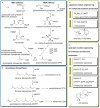Opportunities and challenges for the sustainable production of structurally complex diterpenoids in recombinant microbial systems
- PMID: 28546842
- PMCID: PMC5433224
- DOI: 10.3762/bjoc.13.85
Opportunities and challenges for the sustainable production of structurally complex diterpenoids in recombinant microbial systems
Abstract
With over 50.000 identified compounds terpenes are the largest and most structurally diverse group of natural products. They are ubiquitous in bacteria, plants, animals and fungi, conducting several biological functions such as cell wall components or defense mechanisms. Industrial applications entail among others pharmaceuticals, food additives, vitamins, fragrances, fuels and fuel additives. Central building blocks of all terpenes are the isoprenoid compounds isopentenyl diphosphate and dimethylallyl diphosphate. Bacteria like Escherichia coli harbor a native metabolic pathway for these isoprenoids that is quite amenable for genetic engineering. Together with recombinant terpene biosynthesis modules, they are very suitable hosts for heterologous production of high value terpenes. Yet, in contrast to the number of extracted and characterized terpenes, little is known about the specific biosynthetic enzymes that are involved especially in the formation of highly functionalized compounds. Novel approaches discussed in this review include metabolic engineering as well as site-directed mutagenesis to expand the natural terpene landscape. Focusing mainly on the validation of successful integration of engineered biosynthetic pathways into optimized terpene producing Escherichia coli, this review shall give an insight in recent progresses regarding manipulation of mostly diterpene synthases.
Keywords: enzyme engineering; heterologous production in E. coli; metabolic pathway optimization; modular biosynthesis; plant diterpenes.
Figures



Similar articles
-
Metabolic engineering and synthetic biology for isoprenoid production in Escherichia coli and Saccharomyces cerevisiae.Appl Microbiol Biotechnol. 2021 Jan;105(2):457-475. doi: 10.1007/s00253-020-11040-w. Epub 2021 Jan 4. Appl Microbiol Biotechnol. 2021. PMID: 33394155 Review.
-
Metabolic engineering and synthetic biology approaches driving isoprenoid production in Escherichia coli.Bioresour Technol. 2017 Oct;241:430-438. doi: 10.1016/j.biortech.2017.05.168. Epub 2017 May 29. Bioresour Technol. 2017. PMID: 28599221 Review.
-
Biosynthesis of plant isoprenoids: perspectives for microbial engineering.Annu Rev Plant Biol. 2009;60:335-55. doi: 10.1146/annurev.arplant.043008.091955. Annu Rev Plant Biol. 2009. PMID: 19575586 Review.
-
Genetic engineering of yeast, filamentous fungi and bacteria for terpene production and applications in food industry.Food Res Int. 2021 Sep;147:110487. doi: 10.1016/j.foodres.2021.110487. Epub 2021 May 31. Food Res Int. 2021. PMID: 34399483 Review.
-
Metabolic engineering of volatile isoprenoids in plants and microbes.Plant Cell Environ. 2014 Aug;37(8):1753-75. doi: 10.1111/pce.12316. Epub 2014 May 6. Plant Cell Environ. 2014. PMID: 24588680 Review.
Cited by
-
Current understanding and biotechnological application of the bacterial diterpene synthase CotB2.Beilstein J Org Chem. 2019 Oct 2;15:2355-2368. doi: 10.3762/bjoc.15.228. eCollection 2019. Beilstein J Org Chem. 2019. PMID: 31666870 Free PMC article. Review.
-
Proteomic Insights on the Metabolism of Penicillium janczewskii during the Biotransformation of the Plant Terpenoid Labdanolic Acid.Front Bioeng Biotechnol. 2017 Jul 31;5:45. doi: 10.3389/fbioe.2017.00045. eCollection 2017. Front Bioeng Biotechnol. 2017. PMID: 28824907 Free PMC article.
-
Engineering metabolic pathways in Amycolatopsis japonicum for the optimization of the precursor supply for heterologous brasilicardin congeners production.Synth Syst Biotechnol. 2018 Jan 12;3(1):56-63. doi: 10.1016/j.synbio.2017.12.005. eCollection 2018 Mar. Synth Syst Biotechnol. 2018. PMID: 29911199 Free PMC article.
-
18-Hydroxydolabella-3,7-diene synthase - a diterpene synthase from Chitinophaga pinensis.Beilstein J Org Chem. 2017 Aug 23;13:1770-1780. doi: 10.3762/bjoc.13.171. eCollection 2017. Beilstein J Org Chem. 2017. PMID: 28904620 Free PMC article.
-
Progress and prospects in metabolic engineering approaches for isoprenoid biosynthesis in microalgae.Biotechnol Biofuels Bioprod. 2025 Jun 18;18(1):64. doi: 10.1186/s13068-025-02665-y. Biotechnol Biofuels Bioprod. 2025. PMID: 40533766 Free PMC article. Review.
References
Publication types
LinkOut - more resources
Full Text Sources
Other Literature Sources
